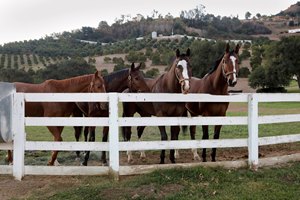Industry Commits to Aid Following Fire at San Luis Rey


Every few minutes at Del Mar the morning of Dec. 8, an alert went out on the barn area public address system, requesting veterinary assistance for the approximately 850 animals on the grounds.
Upon hearing the alert, vets ran to where they were called to address any number of issues. It wasn't entirely chaos and it wasn't entirely organized. The effort was just that—effort.
The horror of a devastating fire Dec. 7 at San Luis Rey Training Center has been followed a day later by an overwhelming effort in Southern California to save and care for evacuated horses.
BALAN: Horsemen Report Equine Deaths in San Luis Rey Fire
Of the 450 to 500 Thoroughbreds that were stabled at San Luis Rey Thursday, between 350 to 370 are on the grounds at Del Mar, another 100 or so are at Trifecta Equine Athletic Center, which sits across the street from San Luis Rey in Bonsall, Calif., and other horses are scattered about the region. Approximately 590 other animals (mostly horses) fleeing fires in the region are also stabled at Del Mar.
Those working at Trifecta to treat and care for horses Friday morning could still see smoke wafting up from the barns at San Luis Rey, where the California Horse Racing Board estimated 25 horses died Thursday in a fast-moving brushfire that swept through the stable area and destroyed barns.
These are all horses at Trifecta from San Luis Rey. Barn manager Annabelle Weller-Polly says 70 or more are here from SLR. pic.twitter.com/NZt2jGX3Lu
— Jeremy Balan (@BH_JBalan) December 8, 2017
Tim Ritvo, chief operating officer for The Stronach Group, which owns San Luis Rey, said Friday the equine death toll is around 40. Ritvo said nine barns at San Luis Rey were destroyed by the fire. He is hopeful horses can be back into intact stalls at San Luis Rey in a few weeks.
At first glance Friday, the crowd at Del Mar looked comparable to a raceday at the seaside racetrack. With stable area parking full, cars from volunteers overflowed into the track's main parking lot.
"The only way to really be organized with something like this is to show up and see what's needed," said CHRB executive director Rick Baedeker, who was on-site at Del Mar to help coordinate the effort. "That's why we're here. We have a mix of horses here, so we're working with Del Mar to create a separation. But we're also being careful not to put up roadblocks. We want to facilitate (the effort), not get all bureaucratic about it.
"When I saw all the people here—you talk about heartwarming instances in the midst of tragedy. It's amazing."
Back at Trifecta, barn manager Anabelle Weller-Poley said in the late morning that almost all of the evacuated horses on the grounds have been identified and the facility is working to contact as many trainers as possible. Some horsemen already moved horses out of the facility, and Weller-Poley said helicopters used to fight fires in the region have consistently dipped into Trifecta's lakes on the infield of its training track to gather much-needed water.
Korin Potenza, the veterinarian who runs Trifecta, said in the early morning that staff at the facility were still treating horses with burns and lacerations, but that since the evacuated horses arrived, none have died or been euthanized. Many of the horses at Trifecta were loose horses collected by the farm's staff after they were released from their San Luis Rey stalls by barn workers so they could flee the fire.
Injured horses are in stalls at the facility. The majority of the evacuated horses, however, are in fenced-in fields and outdoor pens.
Staff from the region's racetracks and volunteers are still working to identify as many horses as possible at Del Mar and at other locations, and horsemen are doing their best to keep track. Trainer Richard Baltas even resorted to duct tape and permanent marker to label his horses' stalls and halters at Del Mar.
Baedeker also indicated Del Mar is working toward getting the main track prepared for training, and is hopeful that can be achieved by Dec. 9, to at least facilitate jogging.
Owner and former jockey Jeff Bloom, who safely recovered the three horses he had stabled at San Luis Rey, said track work would be beneficial for horses in good health, to get them back into a regular rhythm and get them exercise out of the barn.
"For the horses that aren't injured, it's the best thing you can do," Bloom said.
